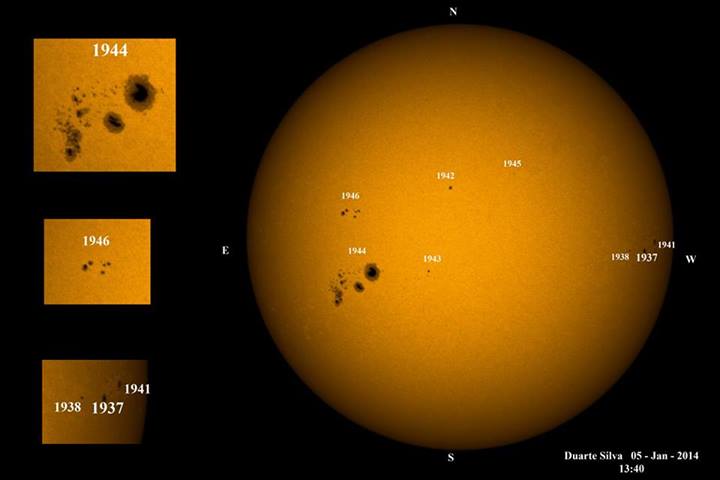Como é que é feita a numeração das manchas solares?
Os números das manchas solares são atribuídos pelo Space Environment Center, que faz parte do
National Oceanic and Atmospheric Administration (NOAA). Os grupos de manchas são numerados sequencialmente à medida que vão sendo identificados. Se um grupo der uma volta completa ao Sol e aparecer do outro lado recebe um novo número.
Consta que a numeração começou a ser feita algures nos anos 60 pelo físico solar Pat McIntosh. Algures em 1970 começou a contar-se novamente a partir do zero.
A numeração atual começou a 5 de janeiro de 1972.
O que é efetivamente numerado não são as manchas individuais mas sim os grupos de manchas ou regiões ativas no Sol as quais podem conter diversas manchas. Antes de ser dado o número a região deve ser identificada pelo menos por dois observatórios diferentes.
AR5128, por exemplo, refere-se à região ativa numero 5128 detetada desde 5 de janeiro de 1972. A 14 de junho de 2002 o contador atingiu o numero 10000. Por questões práticas optou-se por continuar a utilizar apenas 4 algarismos. Assim do 9999 passamos para o 0000 e depois 0001 etc. Por exemplo a região ativa 10030 é referida como
AR0030 ou simplesmente região ativa 30.
Para mais informações ver:
https://sohowww.nascom.nasa.gov/classroom/notsofaq.html#NOAA_NUMBERS
https://hesperia.gsfc.nasa.gov/sftheory/questions.htm

How are sunspots numbered?
Sunspot numbers are assigned by the Space Environment Center, which is part of the National Oceanic and Atmospheric Administration (NOAA). Spot groups are numbered sequentially as they are identified. If a group circles the Sun completely and appears on the other side, it receives a new number.
We believe that numbering began sometime in the 1960s by solar physicist Pat McIntosh. Sometime in 1970, people started counting up again from zero. Current numbering began on January 5th, 1972. What is effectively numbered are not individual spots but groups of spots or active regions on the Sun, which may contain several spots. Before the number is given, the region must be identified by at least two different observatories.
AR5128, for example, refers to the active region number 5128 detected since January 5, 1972. On June 14, 2002, the counter reached the number 10000. For practical reasons, it was decided to continue using only 4 digits. So, from 9999 we move to 0000 and then 0001. For example, active region 10030 is referred to as AR0030 or simply active region 30.
For more information see:
https://sohowww.nascom.nasa.gov/classroom/notsofaq.html#NOAA_NUMBERS
https://hesperia.gsfc.nasa.gov/sftheory/questions.htm
